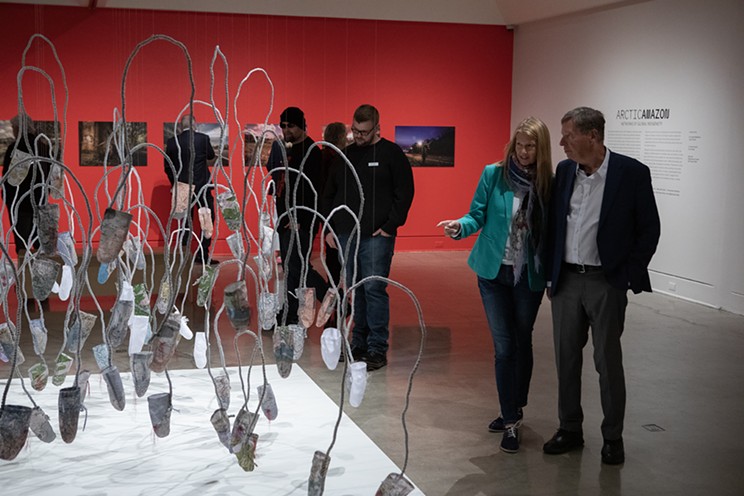Even though the third floor of the Art Gallery of Nova Scotia’s north building is closed to the public, a cacophony of noise fills the space. Competing chanting from two nearby video installations cross over one another, while the adjoining hallway’s vermillion-red walls are loud enough to register over both. Around the corner, a dozen sculptural balloons softly shift in the recycled air, a collection of whispers that amplify the sound that came before. It borders on obvious to say that Arctic/Amazon: Networks of Global Indigeneity is about pluralism of voices, but that doesn’t make the chorus any less powerful—especially as the sweeping installation, which occupies both the lower and third floors of the gallery’s north building from May 11 to Sept. 17, makes room for each individual voice to be heard.
Borne from a symposium in 2019, the show—which arrives at the AGNS from Toronto’s Power Plant Gallery—features works by 17 artists, all Indigenous peoples of either Arctic or Amazon nations. Each work varies in message and medium, though common themes recur—particularly surrounding colonialism, environmentalism and the artists’ connection to their respective cultures.
“I think one of the things that makes this show really strong is that all of the artists brought themselves into the space. So I got the impression that everybody was true to their practice and true to their own artwork. And then, the curators bringing the selected artists together: You know, that's what kind of allows for these connections to be made,” Couzyn van Heuvelen, an artist with works in the show, says. “Even connections, artists to artists—a lot of us got to meet—but also connections between work and seeing some of the similarities in the work.”
van Heuvelen’s piece—a mixed-media installation of a sled on breaking ice—is inspired by ”my hometown, Iqaluit,” he tells The Coast, softly gazing at his work as he searches for the perfect words. “The moment when the ice breaks up and flows out to sea.”
The remainder of the gallery’s lower level floor space is pulled into the gravitational orbit of the installation by Sonya Kelliher-Combs: Mittens patterned with vintage maps are suspended in the air, casting shadows across a white platform. The red fringe each pair sports is tied to a site where a “credible claim of abuse” has been made against the Catholic church by Indigenous communities.
Upstairs, alongside the video installations from Amazonian artists, rooms are filled with replicas of traditional Inuit fish hooks over two metres long; mirrored, looping videos of traditional dancers; and the aforementioned sculptural balloons, also by van Heuvelen: Shimmering silver shapes that call early Andy Warhol to mind while representing a pod of seals swimming through an Arctic river.
“We have a fortune of being able to go places and see things and hear what's going on in the world and listen to artists, and listen to curators, and listen to the people who are raising questions. And working with a number of artists very closely, it became clear that this network of global Indigeneity was something that was obviously happening globally. So when we traveled and saw our own artists, in conversations with other artists in places like Italy, that was really exciting, and opened a lot of doors, and thinking,” begins interim director and CEO of the AGNS Sarah Moore-Fillmore. “And those connections are really the things that help tell stories. And then understanding that Couzyn van Heuvelen—who went to NASCAD, and whose work has been evolving in this really beautiful way—to be able to tell his stories and bring that work back to life: It just kind of clicked like this could be a really great homecoming, it could be a chance to tell a global story with work that had resonance here in Mi'kma'ki.”
She continues: “But it wasn't until all the pieces came together and we realized we had the opportunity to present the show with the North American Indigenous Games coming to town and be able to expand this really exciting cultural moment. And connect beyond our collection. This was the time.”



